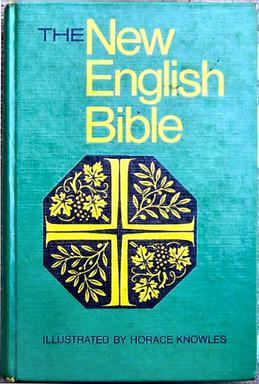
The Bible has been translated into many languages from the biblical languages of Hebrew, Aramaic, and Greek. As of November 2024 the whole Bible has been translated into 756 languages, the New Testament has been translated into an additional 1,726 languages, and smaller portions of the Bible have been translated into 1,274 other languages according to Wycliffe Global Alliance. Thus, at least some portions of the Bible have been translated into 3,756 languages.
More than 100 complete translations into English languages have been produced. Translations of Biblical books, especially passages read in the Liturgy can be traced back to the late 7th century, including translations into Old and Middle English.

The God's Word Translation (GW) is an English translation of the Bible. God's Word to the Nations Mission Society managed and funded the translation.

The New Living Translation (NLT) is a translation of the Bible in contemporary English. Published in 1996 by Tyndale House Foundation, the NLT was created "by 90 leading Bible scholars." The NLT relies on recently published critical editions of the original Hebrew, Aramaic, and Greek texts.

The New American Standard Bible is a translation of the Bible in contemporary English. Published by the Lockman Foundation, the complete NASB was released in 1971. New revisions were published in 1995 and 2020. The NASB relies on recently published critical editions of the original Hebrew, Aramaic, and Greek texts. It is known for preferring a literal translation style that generally preserves the structure of the original language when possible, rather than an idiomatic style that attempts to match natural English usage.

The New English Bible (NEB) is an English translation of the Bible. The New Testament was published in 1961 and the Old Testament (with the Apocrypha) was published on 16 March 1970. In 1989, it was significantly revised and republished as the Revised English Bible.
The New English Translation (NET) is a free, "completely new" English translation of the Bible, "with 60,932 translators' notes" sponsored by the Biblical Studies Foundation and published by Biblical Studies Press.

Modern English Bible translations consists of English Bible translations developed and published throughout the late modern period to the present.

The Amplified Bible (AMP) is an English language translation of the Bible produced jointly by Zondervan and The Lockman Foundation. The first edition as a complete volume was published in 1965. "Amplifications" are words or phrases intended to more fully bring out the meaning of the original text but distinguished from the translation itself by a unique system of brackets, parentheses, and italics. The translation is largely one of formal equivalence (word-for-word).
Literal translation, direct translation, or word-for-word translation is the translation of a text done by translating each word separately without analysing how the words are used together in a phrase or sentence.
Green's Literal Translation or the Literal Translation of the Holy Bible (LITV) is a translation of the Bible by Jay P. Green Sr., first published in 1985. The LITV takes a literal, formal equivalence approach to translation. The Masoretic Text is used as the Hebrew basis for the Old Testament, and the Textus Receptus is used as the Greek basis for the New Testament. This translation is available in book form and is freely available online for use with the e-Sword software program. Some also refer to it as the "KJ3" or "KJV3".
There have been various debates concerning the proper family of biblical manuscripts and translation techniques that should be used to translate the Bible into other languages. Biblical translation has been employed since the first translations were made from the Hebrew Bible into Greek and Aramaic. Until the Late Middle Ages, the Western Church used the Latin Vulgate almost entirely while the Eastern Church, centered in Constantinople, mostly used the Greek Byzantine text. Beginning in the 14th century, there have been increasing numbers of vernacular translations into various languages. With the development of modern printing techniques, these increased enormously.
The Concordant Version is an English translation of the Bible compiled by the Concordant Publishing Concern (CPC), which was founded by Adolph Ernst Knoch in 1909. The principal works of the CPC is the Concordant Literal New Testament with Keyword Concordance (CLNT), and the Concordant Version of the Old Testament (CVOT). Knoch designed the Concordant Version to put English readers lacking formal knowledge of Koine Greek in possession of all the vital facts of the most ancient codices: Codex Vaticanus, Codex Sinaiticus, and Codex Alexandrinus. The CPC's efforts yielded a restored Greek text, titled The Concordant Greek Text, containing all of the important variant readings found in the codices mentioned above. This was done with the intent of conforming, as far as possible, to the original autograph manuscripts. An utterly consistent hyper-literal sub-linear based upon a standard English equivalent for each Greek element is to be found beneath each Greek word. The Concordant Greek Text forms the basis of the CLNT, which is more idiomatic in its English than the hyper-literal sublinear. The CLNT and the Concordant Greek Text are linked together and correlated for the English reader by means of an English concordance—the Keyword Concordance—and a complementary list of the Greek elements.

Translation is the communication of the meaning of a source-language text by means of an equivalent target-language text. The English language draws a terminological distinction between translating and interpreting ; under this distinction, translation can begin only after the appearance of writing within a language community.

Good News Bible (GNB), also called the Good News Translation (GNT) in the United States, is an English translation of the Bible by the American Bible Society. It was first published as the New Testament under the name Good News for Modern Man in 1966. It was anglicised into British English by the British and Foreign Bible Society with the use of metric measurements for the Commonwealth market. It was formerly known as Today's English Version (TEV), but in 2001 was renamed the Good News Translation in the U.S., because the American Bible Society wished to improve the GNB's image as a translation where it had a public perception as a paraphrase. Despite the official terminology, it is still often referred to as the Good News Bible in the United States. It is a multi-denominational translation, with editions used by many Christian denominations. It is published by HarperCollins, a subsidiary of News Corp.

Eugene Albert Nida was an American linguist who developed the dynamic equivalence theory of Bible translation and is considered one of the founders of modern translation studies.
Skopos theory is a theory in the field of translation studies that employs the prime principle of a purposeful action that determines a translation strategy. The intentionality of a translational action stated in a translation brief, the directives, and the rules guide a translator to attain the expected target text translatum.

The earliest preserved translation of the Bible into the Mongolian language dates to 1827, but there is a written record of what may perhaps have been a translation existing as early as 1305. Since 1827, numerous other translations have been made.
Sense-for-sense translation is the oldest norm for translating. It fundamentally means translating the meaning of each whole sentence before moving on to the next, and stands in normative opposition to word-for-word translation.

The Christian Standard Bible (CSB) is a translation of the Bible in contemporary English. Published by Holman Bible Publishers in 2017 as the successor to the Holman Christian Standard Bible (HCSB), the CSB "incorporates advances in biblical scholarship and input from Bible scholars, pastors, and readers to sharpen both accuracy and readability." The CSB relies on recently published critical editions of the original Hebrew, Aramaic, and Greek texts.












